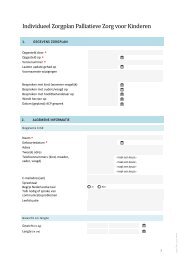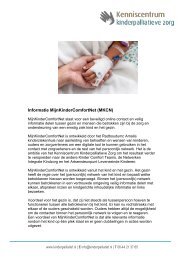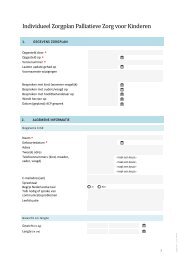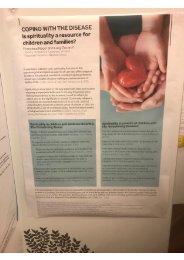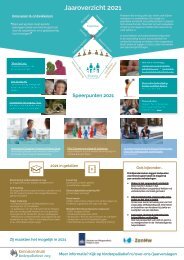EAPC Atlas of Palliative Care in Europe 2019
Conclusion: PC health policies developed in recent years have promoted vigorous development across Europe. Preliminary data on the integration of PC into different fields are encouraging though inequalities between countries and sub-regions persist. Further comparative analysis exploring factors leading to uneven progress may inform strategies to provide PC for all people in need. Per land is de stand van zaken van de (kinder)palliatieve zorg weergegeven.
Conclusion: PC health policies developed in recent years have promoted vigorous development across Europe. Preliminary data on the integration of PC into different fields are encouraging though inequalities between countries and sub-regions persist. Further comparative analysis exploring factors leading to uneven progress may inform strategies to provide PC for all people in need.
Per land is de stand van zaken van de (kinder)palliatieve zorg weergegeven.
Create successful ePaper yourself
Turn your PDF publications into a flip-book with our unique Google optimized e-Paper software.
POPULATION AND METHODS<br />
<strong>Palliative</strong> <strong>Care</strong> needs across <strong>Europe</strong> <strong>of</strong> those who<br />
die with serious health related suffer<strong>in</strong>g every year<br />
B<br />
For the ATLAS we estimate the people affected by serious<br />
health-related suffer<strong>in</strong>g who die every year <strong>in</strong> <strong>Europe</strong> and<br />
each <strong>Europe</strong>an country Includ<strong>in</strong>g only those who die <strong>in</strong> a given<br />
year with life threaten<strong>in</strong>g or life-limit<strong>in</strong>g health conditions.<br />
Worldwide, estimates <strong>of</strong> palliative care needs are been studied<br />
with concern. Global population is <strong>in</strong>creas<strong>in</strong>gly ag<strong>in</strong>g and therefore<br />
have been generat<strong>in</strong>g an <strong>in</strong>creased prevalence <strong>of</strong> non-communicable<br />
diseases and the persistence <strong>of</strong> other chronic and<br />
<strong>in</strong>fectious diseases (WHA 67.19, WHO, 2014 NCDS). This population<br />
<strong>in</strong> need <strong>of</strong> palliative care is estimated to rise significantly <strong>in</strong><br />
the future at the global level.<br />
In this ATLAS the need <strong>of</strong> palliative care for adults was calculated<br />
adapt<strong>in</strong>g the conceptual framework for measur<strong>in</strong>g the global<br />
burden <strong>of</strong> serious health-related suffer<strong>in</strong>g (SHS) <strong>of</strong> the Lancet<br />
Commission Report on <strong>Palliative</strong> <strong>Care</strong> and Pa<strong>in</strong> Relief (Knaul FM<br />
et al, 2017). SHS is def<strong>in</strong>ed as suffer<strong>in</strong>g associated with a need<br />
for palliative care. The work <strong>of</strong> the Commission estimated the<br />
global burden us<strong>in</strong>g mortality data for 20 conditions, adjusted<br />
for the prevalence <strong>of</strong> both physical and psychosocial symptoms<br />
that cause most <strong>of</strong> the burden <strong>of</strong> SHS.<br />
Based on this burden <strong>of</strong> symptoms they calculate a multiplier for<br />
each condition to estimate the proportion <strong>of</strong> patients with that condition<br />
who can benefit from palliative care. The multiplier refers to<br />
the percentage applied to the total number <strong>of</strong> deaths <strong>in</strong> each condition<br />
<strong>in</strong> order to calculate the number <strong>of</strong> decedents who need palliative<br />
care <strong>in</strong>clud<strong>in</strong>g both those who die <strong>in</strong> a given year and those who<br />
live with life-threaten<strong>in</strong>g or life-limit<strong>in</strong>g health conditions.<br />
For the ATLAS, consider<strong>in</strong>g only those who died with life threaten<strong>in</strong>g<br />
or life-limit<strong>in</strong>g health conditions <strong>in</strong> 2014, we calculate<br />
the people who died <strong>in</strong> a year experienc<strong>in</strong>g serious health-related<br />
suffer<strong>in</strong>g for each country <strong>of</strong> <strong>Europe</strong>. We took as reference<br />
the same health conditions most <strong>of</strong>ten generat<strong>in</strong>g <strong>Palliative</strong> <strong>Care</strong><br />
need proposed by the Lancet Commission. We retrieved data on<br />
mortality <strong>of</strong> each condition from the WHO <strong>Europe</strong>an Mortality<br />
Database (EMD). Due to different denom<strong>in</strong>ations for conditions<br />
<strong>in</strong> <strong>in</strong> the EMD, some conditions were excluded from the count<br />
(malnutrition, <strong>in</strong>jury, birth trauma-low birth weight, prematurity<br />
and renal failure). Then, we apply the Lancet Commission multiplier<br />
obta<strong>in</strong><strong>in</strong>g the population <strong>in</strong> need <strong>of</strong> palliative care for each<br />
condition <strong>in</strong> every <strong>Europe</strong>an Country.<br />
We use the 2014 data <strong>of</strong> the database as for be<strong>in</strong>g the most complete<br />
and recent one. For countries without data <strong>in</strong> that year<br />
(Albania, Azerbaijan, Ireland, Monaco, Montenegro, Russian Federation,<br />
Switzerland, Tajikistan, Macedonia and Turkmenistan) we<br />
estimated the need us<strong>in</strong>g neighbour’s country’s data as a proxy.<br />
We categorised countries with<strong>in</strong> the Region <strong>in</strong> HIC and LMIC to calculate<br />
the need <strong>of</strong> palliative care for children follow<strong>in</strong>g the Lancet<br />
Commission’s estimation <strong>of</strong> the proportion <strong>of</strong> children <strong>of</strong> the total<br />
who die every year that need palliative care. In low-middle <strong>in</strong>come<br />
countries, this represents 12%, and <strong>in</strong> high-<strong>in</strong>come countries, 0.6%.<br />
The need <strong>of</strong> palliative care for the total population and only for<br />
children who die <strong>in</strong> a given year is presented by country and<br />
breakdown to disease group.<br />
The ATLAS estimates that over 4,4 million people who died <strong>in</strong><br />
2014 <strong>in</strong> <strong>Europe</strong> experienced serious health-related suffer<strong>in</strong>g and<br />
need <strong>Palliative</strong> <strong>Care</strong><br />
Over 139.000 children who die every year need palliative care.<br />
People who died <strong>in</strong> 2014 <strong>in</strong> <strong>Europe</strong> need<strong>in</strong>g <strong>Palliative</strong> <strong>Care</strong><br />
l Diseases <strong>of</strong> the circulatory system<br />
25,65%<br />
l Malignant neoplasm <strong>of</strong> lymphoid<br />
and haematopoietic tissue<br />
2,86%<br />
l Congenital malformations and<br />
chromosomal abnormalitites<br />
0,36%<br />
l Alzheimer’s disease and<br />
other degenerative diseases<br />
<strong>of</strong> the nervous system<br />
2,45%<br />
l Diseases <strong>of</strong> the musculoskeletal<br />
system and connective tissue<br />
0,51%<br />
l Diseases <strong>of</strong> the respiratory system<br />
6,36%<br />
l Pneumonia<br />
1,92%<br />
DCS<br />
MNLHT<br />
CMCA DMSCT<br />
MN<br />
4,468,623 people<br />
who die <strong>in</strong> need<br />
<strong>of</strong> Pallliative <strong>Care</strong><br />
<strong>in</strong> 2014<br />
DRS<br />
P<br />
M<br />
CLDC<br />
IHD<br />
CLRD AH<br />
DDS<br />
CD<br />
<strong>EAPC</strong> <strong>Atlas</strong> <strong>of</strong> <strong>Palliative</strong> <strong>Care</strong> <strong>in</strong> <strong>Europe</strong><br />
33<br />
T<br />
l Malignant neoplasms<br />
37,52%<br />
l Tuberculosis<br />
0,35%<br />
l Cerebrovascular disease<br />
10,80%<br />
l AIDS/HIV<br />
0,24%<br />
l Chronic liver disease and cirrhosis<br />
2,46%<br />
l Diseases <strong>of</strong> the digestive system<br />
2,31%<br />
l Ischaemic heart disease<br />
1,51%<br />
l Chronic lower respiratory diseases<br />
4,70%<br />
l Men<strong>in</strong>gitis<br />
0,01%




